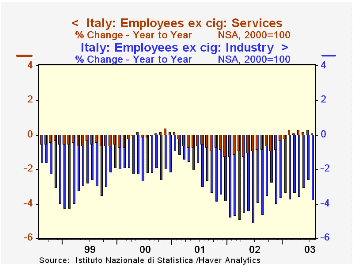 Global| Oct 03 2003
Global| Oct 03 2003Employment Decreases in Italy
Summary
Employment conditions at large Italian companies back-tracked in July, according to data reported on 3 October by Istat, the Italian statistical agency. The number of employees in the industrial sector fell 0.9% in the month and was [...]

Employment conditions at large Italian companies back-tracked in July, according to data reported on 3 October by Istat, the Italian statistical agency. The number of employees in the industrial sector fell 0.9% in the month and was down 3.7% from July 2002. This measure, an index of the number of jobs, had seemed to be stabilizing in June and accompanied a downtick in the second quarter's unemployment rate. So the setback in July's jobs is disappointing. However, it is partially countered by a gain in average hours worked by these employees, which went up 0.5%. Thus, aggregate hours fell just 0.4% in the month. The number of jobs and total hours are both down by roundly 3.5% from a year ago. But productivity of Italian workers is evidently increasing, so that through the second quarter, gross value added in industry had edged lower by only 0.3%.
Service companies and jobs fared better in July. The number of service workers held steady in the month and is even a bit higher than a year ago. The workweek in the service sector is shortening slightly, though, generating a 0.9% decrease in total hours worked since July 2002. Nonetheless, as in the industrial sector, implied productivity gains remain sizable, since value added in services is up some 4.8% over the past year (second quarter 2003/second quarter 2002). This said, these data are collected from "large firms" with over 500 employees; in services, small firms are probably a significant presence in Italy as elsewhere. So employment conditions could be better among those firms, accounting for more of the large gains in value added, rather than such dramatic productivity gains as are suggested by the comparisons described here.
| Seasonally Adjusted | July 2003 | June 2003 | May 2003 | July 2002 | Annual Average|||
|---|---|---|---|---|---|---|---|
| 2002 | 2001 | 2000 | |||||
| Employment in Industry* | 89.9 | 90.7 | 90.8 | 93.4 | 93.5 | 97.6 | 100.0 |
| Hours Worked per Employee in Industry* | 98.5 | 98.0 | 98.0 | 98.4 | 98.5 | 98.9 | 100.0 |
| Employment in Services* | 98.8 | 98.8 | 98.7 | 98.6 | 98.5 | 99.4 | 100.0 |
| Hours Worked per Employee in Services* | 98.6 | 98.4 | 98.8 | 99.6 | 100.1 | 100.1 | 100.0 |
Carol Stone, CBE
AuthorMore in Author Profile »Carol Stone, CBE came to Haver Analytics in 2003 following more than 35 years as a financial market economist at major Wall Street financial institutions, most especially Merrill Lynch and Nomura Securities. She had broad experience in analysis and forecasting of flow-of-funds accounts, the federal budget and Federal Reserve operations. At Nomura Securities, among other duties, she developed various indicator forecasting tools and edited a daily global publication produced in London and New York for readers in Tokyo. At Haver Analytics, Carol was a member of the Research Department, aiding database managers with research and documentation efforts, as well as posting commentary on select economic reports. In addition, she conducted Ways-of-the-World, a blog on economic issues for an Episcopal-Church-affiliated website, The Geranium Farm. During her career, Carol served as an officer of the Money Marketeers and the Downtown Economists Club. She had a PhD from NYU's Stern School of Business. She lived in Brooklyn, New York, and had a weekend home on Long Island.





